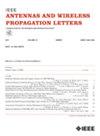A Truncated 2-D Luneburg Lens Antenna with Planar Feeding Surface Using PCB Technology for Stable Wide-Angle Beam-Steering Applications
IF 4.8
2区 计算机科学
Q2 ENGINEERING, ELECTRICAL & ELECTRONIC
引用次数: 0
Abstract
A new approach for implementing a truncated Luneburg lens (LL) antenna (LLA) with a planar feeding surface is proposed, aimed at achieving stable wide-angle beam steering in millimeter-wave band. This technique entails the attachment of just two thin, high-permittivity dielectric slabs to the sides of the truncated LL, maintaining the original permittivity distribution of the lens, which ranges from 1 to 2. These high-permittivity dielectric slabs cause an upward shift of the focal points, leading to a focal plane near the truncated surface, with an increased curvature radius. As a result, the phase centers of the feed elements remain closely aligned with the lens's focal points, which is crucial for sustaining high gain and minimizing gain variation. To validate the concept, a nine-element patch antenna array was integrated with the lens to enable beam scanning, and the entire assembly was processed using low-loss printed circuit board technology. Measurement results demonstrated a peak realized gain of 14.09 dBi, with a gain fluctuation of only 0.6 dB across a broad beam-scanning range of ±67° at 30 GHz.基于PCB技术的平面馈电面截断二维Luneburg透镜天线用于稳定广角波束引导
为了实现毫米波波段稳定的广角波束导向,提出了一种平面馈电面截断吕尼堡透镜(LL)天线的实现方法。这种技术只需要将两个薄的、高介电常数的介质板附着在截短的LL的两侧,保持透镜的原始介电常数分布,范围从1到2。这些高介电常数介质板引起焦点的向上移动,导致焦平面附近的截断表面,增加曲率半径。因此,进给元件的相位中心仍然与透镜的焦点紧密对齐,这对于维持高增益和最小化增益变化至关重要。为了验证这一概念,将一个九元贴片天线阵列集成到透镜中以实现波束扫描,整个组件使用低损耗印刷电路板技术进行处理。测量结果表明,在30 GHz的±67°宽波束扫描范围内,峰值实现增益为14.09 dBi,增益波动仅为0.6 dB。
本文章由计算机程序翻译,如有差异,请以英文原文为准。
求助全文
约1分钟内获得全文
求助全文
来源期刊
CiteScore
8.00
自引率
9.50%
发文量
529
审稿时长
1.0 months
期刊介绍:
IEEE Antennas and Wireless Propagation Letters (AWP Letters) is devoted to the rapid electronic publication of short manuscripts in the technical areas of Antennas and Wireless Propagation. These are areas of competence for the IEEE Antennas and Propagation Society (AP-S). AWPL aims to be one of the "fastest" journals among IEEE publications. This means that for papers that are eventually accepted, it is intended that an author may expect his or her paper to appear in IEEE Xplore, on average, around two months after submission.

 求助内容:
求助内容: 应助结果提醒方式:
应助结果提醒方式:


